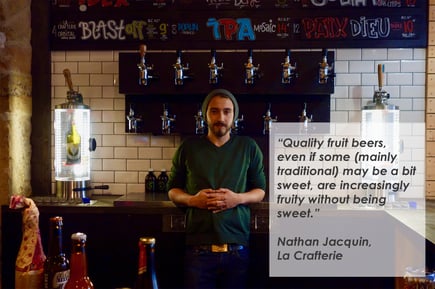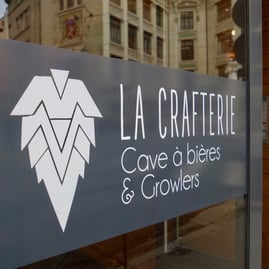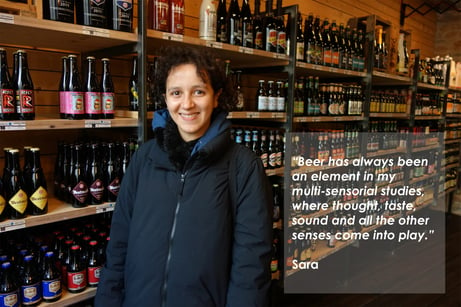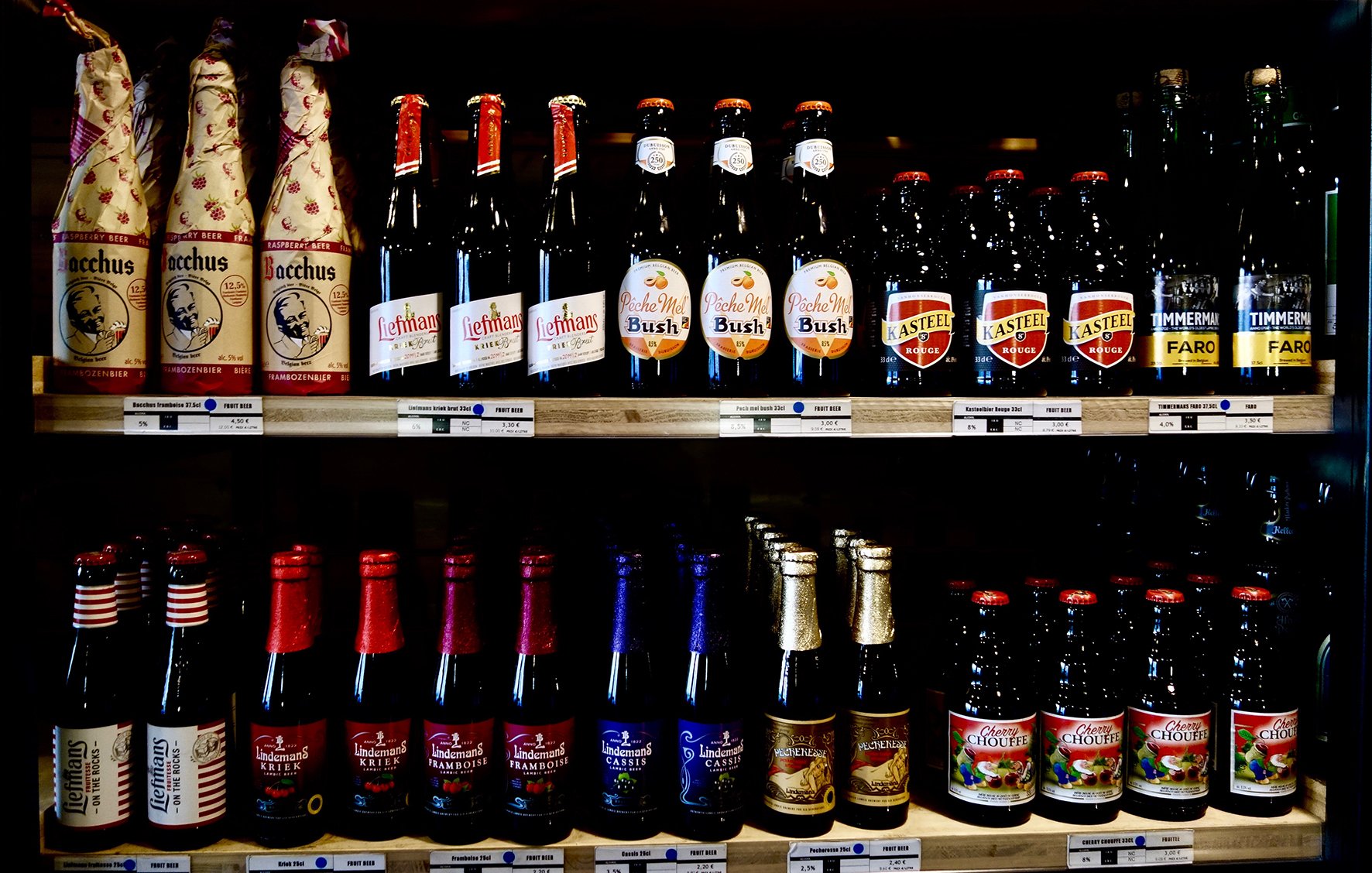Innovative craft beer is on the rise! Fruit has now become an essential part of this new trend, adding a new dimension to the drinking experience. A look at how hop fields and fruit orchards are getting together to enter the urban landscape.
Oenology (from the Greek oînos – wine and lógos – science or discourse) is the well-known art of wine tasting. It’s time to talk about the less familiar term of zythology (zythos – beer in Greek) or, as the Belgian comedian Ronny Coutteure has named it: “beerology”.
Whatever the term one prefers, beer, and in particular craft beer (often with fruit), is undergoing both a renaissance and revolution.
The French-language inouixcurus web site summarizes the trend:
“In 2020, craft beer made by micro-breweries, will represent 20% of the market (source: Brewers Association). The massive launch of alternative brands in the European market and the explosion of micro-breweries (over 800 in France to this day) are part of a new consumer experience. With beerology, zythology and tasting clubs, beer consumption is becoming a distinctive art. The secret of this success? A growing offer based on taste, quality and creativity, which is attracting consumers looking for a genuine experience and more… This rejuvenated product image is developing as a counterpoint to industrial giants using traditional beermaking methods…”
To beer or not to beer
The rise of a wide variety of beer flavors, in particular those enhanced by fruit, has become the focus of a major debate, similar to other issues for consumers and food and beverage makers. So, what are the most relevant questions?
The first question is how to define à “real” beer. The Reinheitsgebot or “law on the purity of beer”, implemented in Bavaria in 1516, strictly limits the ingredients that can be used in brewing: hops, barley malt and water. This decree, extended in 1906 to Germany as a whole, brought on the disappearance of several aromatically-flavored beers, produced in several regions, in particular cherry-beers made in the northern parts of the country. This trend is now going through a major change in Germany (and elsewhere), as expressed by The Independent in London: “Sour styles, such as Lambic, Berliner Weisse or Gose, may be the most obvious fit for fruity additions, where the flavors of ingredients such as cherries and raspberries naturally enhance the sharpness created by wild fermentation.”
If we cross the German border to Belgium, where they’ve been brewing beer since the 11th century, Lambic (a name derived from their unique fermentation process, using a type of still) is often too bitter to be consumed as is. This is why Lambic Kriek has always been fermented a second time with added fruit, in particular cherries. This classical beer keeps its dry taste, like its traditional sister, Gueuze. Lambic is also often flavored with raspberry, peache, blackcurrant, grape, strawberry and even apple, banana, plum, lemon (like white beer) or blueberry. Fruits are also used in many stouts.
Too sweet or not too sweet
There is another preconceived notion that affects people’s willingness to try fruity beers, often considered to imply a sweet taste, a notion that affects both traditional and contemporary craft beers. This, however, is far from the truth. As Nathan Jacquin, partner and zythologist at La Crafterie in Lyon explains: “Quality fruit beers, even if some (mainly traditional) may be a bit sweet, are increasingly fruity without being sweet. This is particularly true for sour beers, such as IPAs (India Pale Ale). In fact, the balance of fruitiness and bitterness in beer is a bit like the balance between fruitiness and minerality in wine. A Condrieu (which uses Viognier grapes) or a good Chardonnay, for example, are perfect illustrations of this principle. On the other hand, there are beers that are deliberately sweet, such as the Mango Citra Milkshake IPA made by the Grand Paris brewery, where we enter a world that is closer to Sauternes or other sweet wines. The Grand Paris Brasserie, a highly-reputed quality French brewer, offers a large range of flavored beers, such as its new vanilla and cinnamon Mexican Imperial Porter, with a touch of chili pepper, which is anything but sweet.”
 Are fruity beers a girl thing?
Are fruity beers a girl thing?
Another preconceived notion is that fruity beers essentially target a feminine (and mainly young) market. The Maloan French-language blog expresses this prejudice in an ironic and provocative way: “Women drink sweet beer. It’s a well-known fact. Fruity beer, sweetened and without too much alcohol (a woman drinks a couple of glasses and she’s tipsy). That’s what big brewers have claimed… by launching a host of flavored beers, adding a few flowers on the packaging and off we go. But, are women’s tastes really limited to that, sweet sodas and a bit of alcohol?”
This article and several others, such as “Les femmes et la bière : Stop aux stéréotypes et idées reçues” (Women and beer: Let’s stop the stereotypes and preconceived ideas) in the Une Petite Mousse blog remind us that this myth is in contradiction with the history of beer as well as current consumption. To begin with, beer is a feminine invention (yup, guys!), which can be traced back to over 10,000 years ago in Mesopotamia, when women, whose job was to make bread with fermented barley, became the first brewers. The blog also tells us: “In Babylonia, 4,000 years ago, women brewed and even sold their beer… Recognized as beneficial for the body, it is said that Cleopatra took beer baths to enhance her skin! And among the Gauls, brewing was a know-how that only woman had and practiced.” In our day and age, more and more women in many countries brew and consume beer: the real thing in fact!
 Art and philosophy
Art and philosophy
Sara, who recently moved to Lyon, France, loves beer and is actively involved in her very personal, eclectic and avant-garde reflection on the culture of beer. Student of Philosophy, History and electroacoustic composition, she expresses her point of view :
“Beer has always been an element in my multi-sensorial studies, where thought, taste, sound and all the other senses come into play. In every sip, I look for different feelings and changes in feelings, as I do with every word and every sound. Vincent, a zythophile friend, is a researcher in auditive perception. He’s taught me a great deal, inspired me in my own research and has helped me discover some rare beers. Today, largely thanks to him, I savor beer differently. Beyond classical food and drink matching, there is wide field of sensory combinations, what is known as synesthetics (from the Greek syn – with or fusion and aesthesis – sensations). Example: sipping a Mexican Imperial Stout, a very daring beer, while listening to a piece of ambient noise, while maybe eating a piece of dark chocolate cake… You experience the same changes in time and tone in the beer as you do in musical performance. When your drink begins to warm (ambient temperature, ambient music), new and more complex tastes reveal themselves through the multitude of ingredients. This corresponds to a musical moment which are a sum of different frequencies which play themselves out at the same time. It’s a moment of noise, a harmonious chaos, mixing taste and sound.”
The marriage between hop fields and fruit orchards
So, what does Sara think about fruit beers? “To begin with, I don’t like sugar and so I look for fruit without sugar in sour beers. Belgians and Americans are today at the forefront in developing fruit beers, which are often complex, proposing an interesting marriage between hop fields and fruit orchards. The Brasserie Cantillon in Belgium is a good example, where you can find a wide variety of fruit beers. There’s also Almanac Beer in the US, which makes many different fruit beers and, on top of that, creates its packaging with artists who try and give a visual interpretation of the taste of the beer. It’s really an artistic whole!”
However, Sara is also wary of the danger that could damage fruit beers: “They have sometimes been denatured by certain industrial brewers over the last few years, with the addition of sugar, sweeteners and, above all, artificial flavoring in low-end beers. Certain brewers have even added gas to their drinks, as well as syrups, so that in the end you get something that’s closer to soda pop. I hope that at some point, when big brewers, decide to produce quality fruit beers, they will not ignore people who really have taste!”
Pure or purée?
The last question, which directly concerns Les vergers Boiron is whether fruit purées can be used in beer-making. The Quebec French-language site, Bière et Plaisirs, which talks about all the various methods for incorporating fruit into beer, is unequivocal: “purée enables brewers to minimize solids in the fermenting process (as opposed to fresh fruit). It’s also a welcome ingredient that enables brewers to use rare or exotic fruits.” Les vergers Boiron has worked closely with brewers for several years to integrate purées in their manufacturing processes.
For more information on the use of Les vergers Boiron purées in craft brewing and some technical tips to achieve the best results, we invite you to check out our online article on the subject: Farm. Fruit. Ferment.

